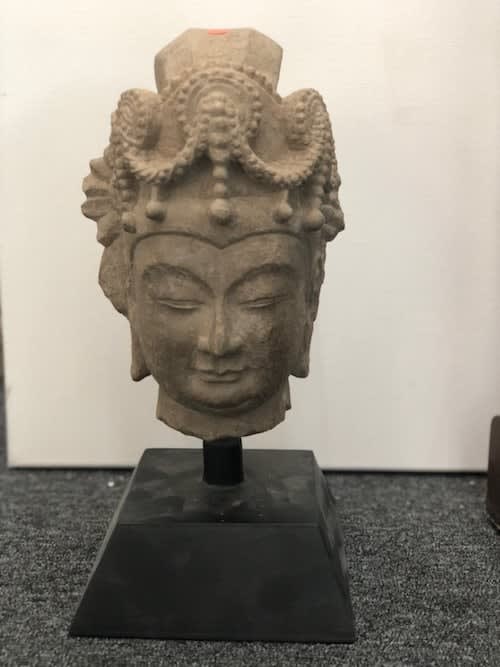Sui Stone Head of a Bodhisattva, 581 CE - 618 CE
Stone
7.9
HK.2859
This is a stone sculpture of the head of a Bodhisattva. Peacefully gazing downwards, the figure has a serene facial expression, radiating an approachable and amiable aura. The head is...
This is a stone sculpture of the head of a Bodhisattva. Peacefully gazing downwards, the figure has a serene facial expression, radiating an approachable and amiable aura.
The head is characterized by fleshy features that harmonize the Sui dynasty’s emergent trend toward naturalism with the inherited idealized forms that conventionally conveyed the purity of Buddhist subjects. Here, the Bodhisattva’s broad arched brows and the sweep of the lowered lids lead the eye down the straight nose to the plump lips and slightly upturned chin, before following the softened jawline to the plump cheeks and returning upward to the crown of the head. The full oval face is counterbalanced above by a tall diadem richly carved with a stupa-like image and floral features. Even in its opulence, the diadem follows the standard Sui formula of a three-sided structure with aesthetic attention given to its band.
The head belongs to a mature phase of Sui artistic production, when craftsmen synthesized styles from within and beyond China into graceful yet dynamic compositions that expressed the transcendental majesty of the Buddhist subject, diversifying the visual vocabulary of each region of the empire, while preserving established characteristics in production. Thus, this sculpture embodies the stylistic transition from the Northern Dynasties to Tang Dynasty.
The head is characterized by fleshy features that harmonize the Sui dynasty’s emergent trend toward naturalism with the inherited idealized forms that conventionally conveyed the purity of Buddhist subjects. Here, the Bodhisattva’s broad arched brows and the sweep of the lowered lids lead the eye down the straight nose to the plump lips and slightly upturned chin, before following the softened jawline to the plump cheeks and returning upward to the crown of the head. The full oval face is counterbalanced above by a tall diadem richly carved with a stupa-like image and floral features. Even in its opulence, the diadem follows the standard Sui formula of a three-sided structure with aesthetic attention given to its band.
The head belongs to a mature phase of Sui artistic production, when craftsmen synthesized styles from within and beyond China into graceful yet dynamic compositions that expressed the transcendental majesty of the Buddhist subject, diversifying the visual vocabulary of each region of the empire, while preserving established characteristics in production. Thus, this sculpture embodies the stylistic transition from the Northern Dynasties to Tang Dynasty.
